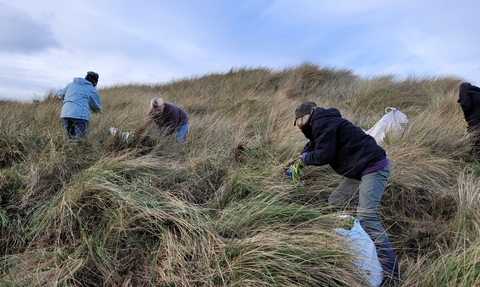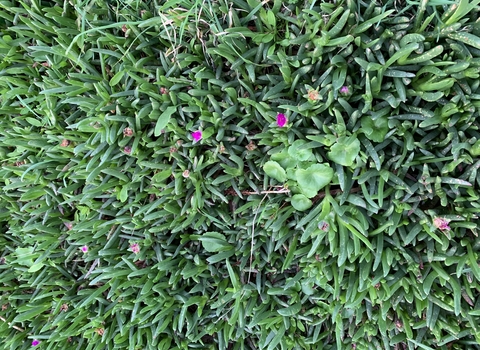Sour Fig (Carpobrotus edulisis) the single biggest threat to Alderney’s coastal habitats. Also known as Ice plant or Sea Fig, it is a robust, flat-growing trailing perennial herb that forms dense mats. The leaves are very green or reddish when older, and succulent, sharply angled and triangular in cross-section, with tiny serrations along the outermost edge. Flowers are solitary and either yellow or pink. Two similar species, Sally-my-handsome, Carpobrotus acinaciformis and Angular Sea Fig, Carpobrotus glaucescen, are also present and invasive in Alderney.
Sour Fig is native to South Africa, but has been introduced to many parts of the world. In Europe it is known from the Mediterranean region and further north in Germany, the UK and Ireland. It was first recorded in Alderney in 1953, but it is thought to have been introduced before this date, as ornamental ground cover. It spreads easily and new patches can form from a very small piece of broken stem. Broken pieces can be moved by rabbits, birds and the wind. Many people, both locals and tourists, also like the appearance of the plant, and cuttings are often taken for gardens. This is likely to contribute to its spread. It is now present throughout the island, in all coastal areas, and poses a major threat to native flora and contributes to coastal erosion.
Sour Fig competes aggressively with native species such as Bastard Toadflax, Small Restharrow, Stemless Thistle and Wild Thyme, and often smothers rare and endangered species. Once established, it spreads quickly and appears to be unaffected by grazing or competition. It is also known to modify soil properties and nutrient dynamics, increasing soil Nitrogen and organic Carbon, and reducing soil pH. This can hinder native flora recolonising after the fig has been removed; and increases the likelihood of scrub species such as bracken and bramble. Finally, Sour Fig can decrease species diversity by preventing sand movement, hindering the natural processes of disturbance and change in dune environments.
What you can do
Gardens
Don’t plant Sour Fig in your garden. Whilst the flowers are attractive, this will only add to the spread of this invasive species. Share the knowledge of the plant’s invasive nature, and the threat it poses to our delicate native plants. Find out more about helping native species and wildlife-friendly gardening on our Wild Gardens page.
Our friends at Little Island Leaves stock many varieties of native flowers that are beneficial to pollinators and other invertebrates and will make a great addition to your garden.
Volunteer
The AWT will run sour fig removal events throughout the year, these are essential if our valuable habitats are to be maintained. Check our Wildlife Volunteers page and get in touch to go on the mailing list.
Sour Fig Action Plan
The AWT undertook GPS mapping in 2008/9 to chart the distribution of Sour Fig on the island and to identify priority areas for removal. Soil sampling was also carried out to investigate the plant’s impact on soil pH. The results revealed that a total of 206km² of Alderney’s coastline, 2.6% of the island’s total area, is covered by Sour Fig or the other closely-related species. Many of the largest areas covered by Sour Fig are inaccessible due to thick scrub and steep cliffs. When prioritising sites for action, the conservation value of sites affected was taken into consideration so areas of coastal and dune grassland have been selected for targeted action. Main areas we work on include the coastline of the Longis reserve and around Saye and Arch bay.
Regarding soil tests, results confirmed a lowered pH in areas covered by Sour Fig. This confirms the plant’s ability to alter environmental conditions, and potentially species composition in the long-term. Furthermore, it was observed that insects, such as bees, were not frequently found on the plant. The spread of Sour Fig could therefore have a further adverse effect on the already declining pollinator population.
In light of these findings, the AWT continues to co-ordinate a programme of removal by hand. This is one of the most effective methods of controlling and reducing coverage by the species. Often, large mats can simply be rolled up, but it is important that all plant material is collected, with none left on site. This material must be kept separate from other green waste and it generally burnt. Post-pull raking of the site is recommended to encourage native regeneration. Finally, fig re-growth is expected, and new growth must be pulled in post-removal sites as it appears.


